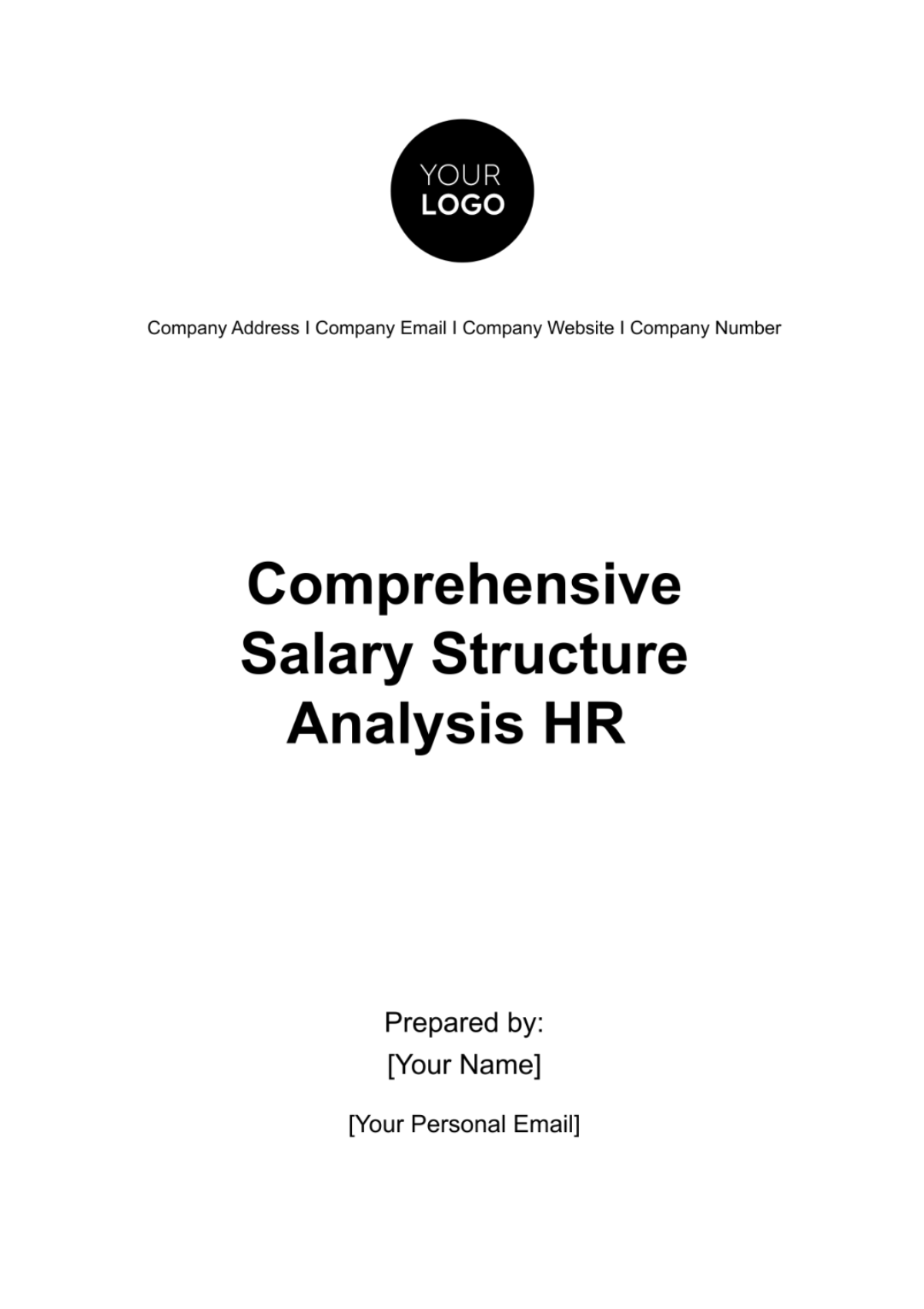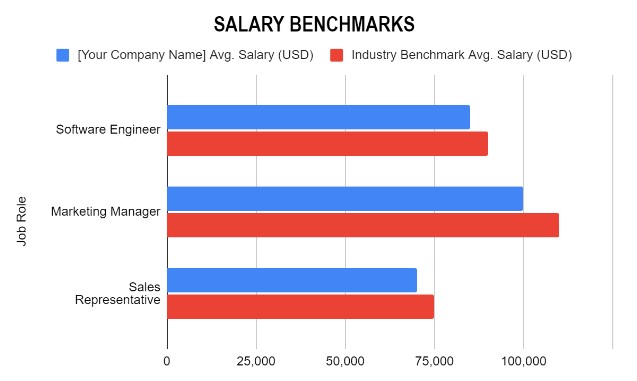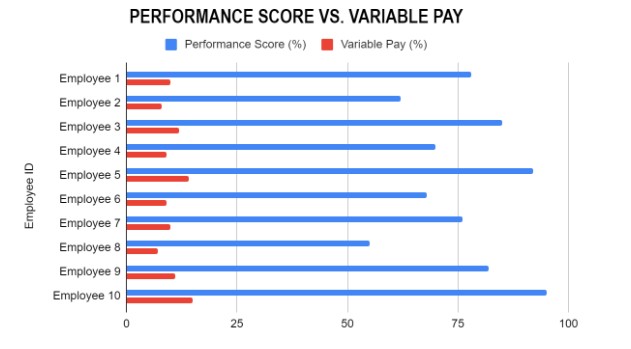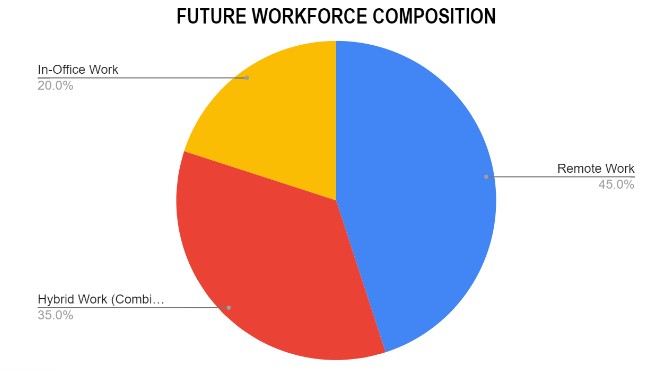Free Comprehensive Salary Structure Analysis HR

Analysis HR
EXECUTIVE SUMMARY
In this comprehensive salary structure analysis, we delve into the intricacies of compensation practices at [Your Company Name]. We aim to provide insights and recommendations that align with your organization's strategic goals while remaining competitive in the ever-evolving job market.
Key Highlights from the Analysis:
Competitive Benchmarking: Our analysis indicates that [Your Company Name]'s current salary levels are generally competitive in the industry. However, we observed that a few key positions within the organization are slightly below market rates. Addressing this issue will be crucial in attracting and retaining top-tier talent.
Internal Equity: [Your Company Name] has maintained a commendable level of internal pay equity. This practice ensures fairness and motivation among employees, contributing to a harmonious work environment. It is recommended to continue conducting regular pay equity audits and adjustments as the organization continues to grow.
Variable Compensation: Our analysis revealed that [Your Company Name]'s variable compensation plans may benefit from refinements to better align with individual and team performance and to closely tie them to the organization's strategic objectives. These adjustments can serve as a powerful tool in motivating and rewarding high performers.
Future Trends: The workplace landscape is evolving rapidly, with a growing emphasis on remote work, flexible schedules, and non-monetary benefits. As these trends gain prominence, [Your Company Name] should consider staying agile and adapting its compensation and benefits packages to remain attractive to both current and prospective employees.
Pay Transparency: While [Your Company Name] maintains internal pay equity effectively, there is room for improvement in terms of pay transparency. Enhancing transparency in compensation policies and practices can foster a culture of trust and fairness among employees.
INTRODUCTION
Effective compensation management is the cornerstone of attracting, retaining, and motivating top talent within any organization. This analysis aims to provide a comprehensive overview of [Your Company Name]'s current salary structure, drawing insights from an array of data sources.
As businesses continue to evolve in the ever-competitive job market of [Year], the importance of aligning compensation practices with organizational goals and market dynamics cannot be overstated. This report serves as a roadmap to help the company navigate these challenges and ensure its compensation strategies remain competitive, equitable, and future-proof.
METHODOLOGY
Our analysis is based on a meticulous and multi-faceted approach to ensure the accuracy and reliability of our findings:
Data Collection: We gathered compensation data encompassing all levels of employees, from entry-level positions to executives. We also conducted employee surveys to gauge satisfaction with the current compensation structure.
Benchmarking: We compared [Your Company Name]'s compensation data with industry-specific salary surveys, ensuring a comprehensive view of your organization's competitive positioning.
Internal Data Review: We meticulously reviewed [Your Company Name]'s internal data on compensation, including historical trends and pay scales for various job roles.
Statistical Analysis: Utilizing advanced statistical tools and methodologies, we performed in-depth analyses to identify trends, outliers, and areas of improvement within the current salary structure.
KEY FINDINGS
Competitive Benchmarking

A. Software Engineer:
[Your Company Name] pays its Software Engineers an average salary of $85,000, which is slightly below the industry benchmark of $90,000.
Interpretation: The organization may consider reviewing and potentially adjusting the compensation for Software Engineers to bring it in line with industry standards. This can help attract and retain top talent in this critical role.
B. Marketing Manager:
[Your Company Name] compensates Marketing Managers with an average salary of $100,000, compared to the industry benchmark of $110,000.
Interpretation: While [Your Company Name]'s compensation for Marketing Managers is competitive, there is a slight gap compared to industry averages. The organization may choose to evaluate whether this gap impacts its ability to attract experienced marketing professionals.
C. Sales Representative:
Sales Representatives at the company earn an average salary of $70,000, whereas the industry benchmark is $75,000.
Interpretation: The company offers a competitive salary for Sales Representatives, with compensation slightly below the industry average. This suggests that the organization is maintaining competitiveness in this role.
Internal Equity
Overall Positive Trend: All three job roles experienced salary increases over the three-year period. This suggests that the organization has been proactive in adjusting compensation to maintain internal equity.
Consistency: This consistency indicates that the company has been successful in maintaining fairness and equity in compensation across these roles during the specified period.
Comparable Growth: While the salary increases for each role are distinct, they are comparable in magnitude. This implies that the company has been mindful of ensuring equitable salary adjustments for different job roles, contributing to a balanced compensation structure.
Implications and Recommendations:
[Your Company Name] has demonstrated a commitment to internal pay equity, as evidenced by the positive trend in salaries for all job roles.
To continue this positive trajectory, it is advisable for [Your Company Name] to conduct regular pay equity audits to ensure that compensation remains competitive and aligned with industry standards.
Consider implementing a performance-based compensation strategy to reward employees for their contributions while maintaining internal fairness.
Variable Compensation

Key observations and insights from the scatterplot:
Performance vs. Variable Pay Spread: The data points suggest that there is diversity among employees in terms of both performance and the extent to which their pay is variable.
Positive Correlation: Upon visual inspection, there appears to be a positive correlation between individual performance scores and variable pay percentages. In other words, as employees' performance scores increase, their variable pay percentages tend to increase as well. This indicates that employees with higher performance scores are often rewarded with a larger variable pay component.
Outliers: Notably, there are a few outliers in the data. For instance, Employee 2 has a relatively low performance score but a moderate variable pay percentage, while Employee 10 stands out with both a high performance score and a substantial variable pay percentage. These outliers may merit further investigation to understand the specific factors influencing their compensation.
Opportunities for Adjustment: The chart suggests that the organization's variable compensation structure is generally aligned with individual performance. However, it also highlights opportunities for refinement. For instance, for employees with exceptionally high performance scores (e.g., Employee 10), there may be room to consider even more substantial variable pay incentives to further motivate and reward top performers.
Performance-Based Compensation Policy: The positive correlation observed underscores the organization's commitment to a performance-based compensation policy. It demonstrates that [Your Company Name] is rewarding employees in a way that reflects their contributions and achievements, which can be a valuable motivator.
Need for Individual Analysis: While the chart offers an overall view of the relationship, it's important to conduct individual performance reviews and consider other factors that might influence compensation decisions. Variables such as job role, market benchmarks, and tenure should be factored into the comprehensive compensation strategy.
Future Trends

The pie chart illustrates the expected composition of the future workforce in terms of work arrangements, providing valuable insights into the evolving employment landscape.
Remote Work (45%): The largest segment of the future workforce is projected to consist of employees working remotely. This trend reflects the growing acceptance and adoption of remote work practices, which offer employees greater flexibility and work-life balance. It also indicates that companies are embracing technology and connectivity to support remote work arrangements.
Hybrid Work (35%): The second-largest portion represents a hybrid work model, where employees split their time between remote work and in-office work. This balanced approach acknowledges the benefits of both remote and in-office work and seeks to strike a harmonious balance that maximizes productivity while accommodating employees' preferences.
In-Office Work (20%): While remote and hybrid work is gaining prominence, a significant portion of the future workforce is expected to remain in traditional in-office roles. This suggests that certain industries or roles may continue to rely on physical office spaces due to the nature of their work, the need for collaboration, or other specific requirements.
Key Takeaways:
Adaptability: Organizations should remain adaptable and responsive to changing workforce preferences. The prevalence of remote and hybrid work indicates the need for flexible policies and technology infrastructure that support these arrangements.
Employee Preferences: The distribution of work arrangements reflects a diversity of employee preferences and needs. Companies should consider tailoring their workforce strategies to accommodate these varied preferences to attract and retain top talent.
Technology Integration: The prominence of remote work emphasizes the importance of robust technology solutions for remote collaboration, communication, and productivity. Investment in such technology will be crucial for organizations looking to thrive in this evolving landscape.
Office Space Planning: For companies with a significant in-office workforce, optimizing office space and creating collaborative, engaging work environments will continue to be a priority. This ensures that in-office employees have an effective and comfortable workspace.
RECOMMENDATIONS
Based on the comprehensive analysis findings, we present a set of strategic recommendations that [Your Company Name] should consider for optimizing its salary structure and compensation practices:
1. Salary Adjustments
Our analysis indicates that certain positions within [Your Company Name] currently fall slightly below market rates. To address this issue and remain competitive in attracting top talent, we recommend the following steps:
Market Analysis: Conduct a detailed market analysis to identify specific roles that require salary adjustments.
Competitive Benchmarking: Regularly benchmark salaries against industry standards to ensure ongoing competitiveness.
Phased Adjustments: Implement salary adjustments in a phased manner to minimize budgetary impact.
2. Variable Compensation Revisions
To enhance alignment with performance and strategic goals, we propose the following recommendations for revising variable compensation plans:
Performance Metrics: Review and refine performance metrics to ensure they accurately reflect individual and team achievements.
Goal Alignment: Align variable compensation structures with strategic objectives, encouraging employees to focus on key organizational priorities.
Communication: Clearly communicate changes to variable compensation plans and provide training to ensure understanding and motivation.
3. Continuous Monitoring
Given the dynamic nature of compensation trends, it's essential for [Your Company Name] to remain proactive. Our recommendations for continuous monitoring include:
Trend Analysis: Regularly review industry and market compensation trends to maintain a competitive edge.
Employee Feedback: Gather feedback from employees regarding compensation and make adjustments based on their input.
Annual Reviews: Conduct comprehensive compensation reviews annually, adjusting as necessary to stay competitive.
4. Enhanced Transparency
To build trust and engagement among employees, we recommend enhancing pay transparency through the following measures:
Policy Communication: Clearly communicate compensation policies and practices to all employees.
Salary Bands: Consider introducing salary bands for roles to provide transparency while allowing for individual variation.
Open Dialogue: Encourage open dialogue about compensation, addressing questions and concerns promptly.
5. Regular Equity Audits
Maintaining internal pay equity is crucial for fostering a fair and motivating work environment. Our recommendations for regular equity audits include:
Periodic Audits: Conduct periodic pay equity audits, especially during periods of growth or role changes.
Address Disparities: Promptly address any disparities identified during audits to ensure continued fairness.
Communication: Communicate the importance of internal pay equity to all employees to foster understanding and support.
CONCLUSION
In conclusion, the comprehensive salary structure analysis conducted for [Your Company Name] provides valuable insights and actionable recommendations for optimizing compensation practices. By implementing these recommendations, the company can achieve several key objectives:
Attract and retain top talent by ensuring competitive salaries.
Motivate and align employees with strategic goals through revised variable compensation plans.
Remain agile and responsive to changing compensation trends.
Cultivate a culture of trust and transparency.
Sustain internal pay equity to foster fairness and job satisfaction.
- 100% Customizable, free editor
- Access 1 Million+ Templates, photo’s & graphics
- Download or share as a template
- Click and replace photos, graphics, text, backgrounds
- Resize, crop, AI write & more
- Access advanced editor
Elevate your compensation strategy with our Comprehensive Salary Structure Analysis HR Template from Template.net. Tailored for businesses of all sizes, this meticulously crafted and user-friendly tool is customizable and editable. It offers in-depth insights and actionable recommendations to fine-tune your organization's compensation practices which can be edited using an Ai Editor Tool. Ensure competitiveness, equity, and employee satisfaction in a rapidly evolving job market.





























